Verräter
Preparazione del gioco
Con il commando /join si possononoire da 3 a 4 giocatori. Con/start la partita ha inizio. Alternatively, you can use the Gothic Instruments!
The Playground
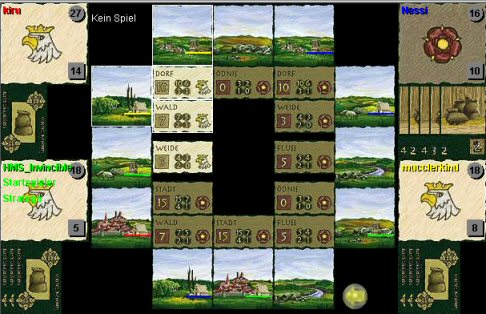
Two princely houses with hostile attitudes are fighting against each other: Eagle and Rose. The players fight for the royal houses and try to conquer the opposing areas and get victory points for doing so. However, who fights for which royal house can change over the course of the game, because there is a little traitor in everyone....
Il tabellone
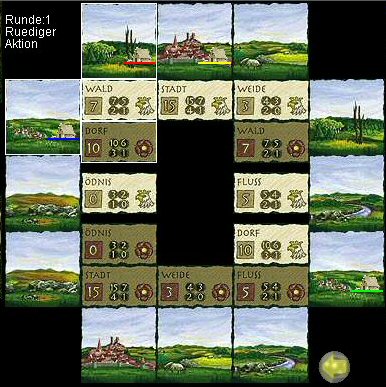
In the middle are the landscapes of the two attitudes Eagle and Rose. At the beginning, each of the two parties has the same landscapes.
Each landscape card contains a lot of information:

- The color and the symbol reflect the attitude
- the number in the square is the number of conflict points (see below)
- The smaller numbers in the circles result in the victory points (see below)
The player displays are arranged around the playing field
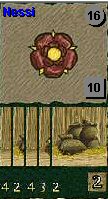
Here you can see the current attitude of a player by color and symbol. His victory points are shown at the top right and the sum of the supply cards played in phase 3 at the bottom right. Below you can see your own supply cards face up, which the other player just covers up.
At the top left you can see the status display

Here you can see the current number of rounds, the active player and the action that he has to carry out.
Svolgimento
The game runs with 3/4 players over 9/8 rounds, each of which is divided into twelve phases.
At the start of the game, each player receives three supply cards with the values 3/4/5. The starting player is determined and the player behind the starting player automatically becomes the strategist for the first round. The order of play is slightly different to other games: top left - bottom left - top right - bottom right; It always starts with the starting player, who moves one place forward in each round.
Now each player takes turns placing a manor.
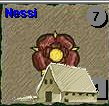 < p> You should make sure that the estate is also shown in your name field. If the office is visible, you can change this by clicking on it. Then you look for one of the landscape fields (preferably one of your own alignment) and place your estate there.
< p> You should make sure that the estate is also shown in your name field. If the office is visible, you can change this by clicking on it. Then you look for one of the landscape fields (preferably one of your own alignment) and place your estate there. Phase 1 - location of conflict determine
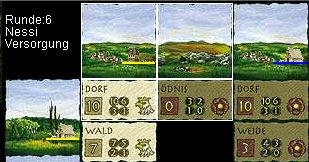
The player who chose the strategist in the previous round may now choose the location of the conflict; i.e. he selects two neighboring landscapes with different attitudes. To do this, he moves the mouse over the landscapes: two neighboring landscapes are always marked with a white frame (in the picture the eagle village and the rose wasteland). If the desired landscapes have the white frame, he confirms the selection with one click.
Phase 2 - Select action card
There are six action cards:
The Strategist

The The player who takes the strategist becomes the strategist in the next round and can thus determine the location of the conflict. He receives two victory points in this round.
The pawn

The farmer receives three supply cards in phase 10.
The builder
{10 }The builder may build a new estate or an office or convert an estate into an office and vice versa.
The Diplomat 5

The Diplomat 5 brings five points of conflict into the fight.
The Diplomat 2

The Diplomat 2 brings two points of conflict into the fight. He also receives an extra supply card in phase 10.
The Traitor
 < p> The traitor changes his allegiance and defects to the opposing house. He receives one victory point.
< p> The traitor changes his allegiance and defects to the opposing house. He receives one victory point. In each round, one action card is sorted face down. Starting with the starting player, each player then chooses one of the remaining action cards.
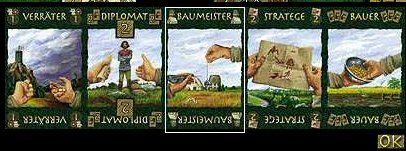
You click on the desired action card and confirm with "OK".
< /span>
Sometimes the window is hidden somewhere on the edge. Then you can grab it with the mouse at the top edge and drag it to the center of the picture.
Phase 3 - play supply cards
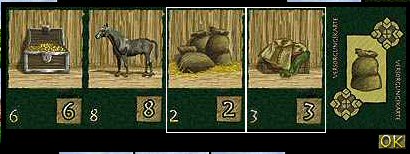
Starting with the starting player, each player takes turns laying out 0-5 supply cards face up in order to strengthen the landscape of their alignment in this conflict. To do this, click on all the cards you want to play. They are marked with a white frame. You then confirm your selection again with "OK".
There are a total of 23 supply cards (5x2, 5x3, 5x4, 5x5, 2x6, 1x8)
Phase 4 - Reveal action cards
Now all action cards are revealed. If there was a traitor in the game, he now changes his allegiance and defects to the other house.
Phase 5 - resolve conflict
< span>Now the points of conflict between the two royal houses are compared. The following count:
- the conflict points on the landscapes involved
- the supply cards played (the traitor's cards now count for the new). House!)
- The conflict points of the two diplomats (5 or 2)
The princely house with the higher total of conflict points wins. If both royal houses have the same number of conflict points, no victory points are distributed for victory. In any case, there are victory points for the traitor (1) and the strategist (2).
Phase 6 - Distribute victory points

The victory points that the players of the victorious house receive are broken down on the landscape card of the losing royal house. The number of victory points per player depends on the number of players in the victorious royal house.
If in the example (village) the victorious house only had one player, this would be with be rewarded with ten points. With two players each would get six points and with three players each would get three points. If all players were of the same opinion, each player only receives one point.
In addition, the traitor now receives one victory point, the strategist two .
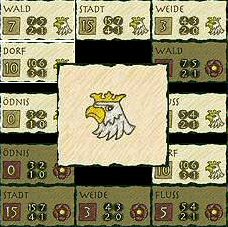
The defeated royal house now changes its attitude. The coat of arms of the winning house is displayed in the middle of the playing field. To continue, each player must click on the coat of arms. This gives everyone the opportunity and enough time to look at the round again in peace.
Phase 7 - Execute action builder
The builder may now build a new manor or office or convert an office into a manor or vice versa; It is also permitted to move a building.
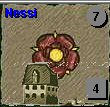

To do this, first select from the name display whether you want to build an estate or an office. Clicking on the building switches from one type to another. Then you select the desired landscape on which the building should be placed with a mouse click. You should note that the estates only bring supply cards if they are on a field of your own alignment.
If you want one If you move a building, you first click on the building, then set the desired building and place it again.

The Buildings are displayed on the landscape spaces with a color bar in the player color. A player may have a maximum of three buildings, of which a maximum of two are offices.
Phase 8 - Execute action Strategist.
Whoever has taken on the role of strategist is now assigned this role and thus has the right to determine the location of the conflict in the next round. One player retains this role until another player selects the Strategist action card. The two additional victory points for the strategist are only available if the action card was selected by him in this round.
Phase 9 - Hand over supply cards
The supply cards played in the conflict are placed on the discard pile.
Phase 10 - draw supply cards
The Farmer always receives three supply cards. All other players, starting with the starting player, then draw a supply card for each estate on a landscape of their own alignment. The player with the Diplomat 2 action card receives an additional supply card.
However, the following applies: no player receives more than three cards and no one is allowed more than five Have cards in hand! For example, a farmer no longer receives cards for his estates because he has already received three cards for his action card "Farmer".
Phase 11 - Return action cards < /h5>
The action cards are collected again and set aside for the next round.
Phase 12 - change of starting player
The player who comes in the order after the current starting player now becomes the starting player and the game starts again from phase 1.
The phases without interaction between the players, in which, for example, only points are calculated or cards are returned, are carried out automatically by the program (phases 4, 5, 6, 8, 9, 11 and 12):
Fine del gioco
The game ends after phase 10, when either a royal house has conquered all landscapes or, with 3/4 players, after the 9th/8th. Round.
Now points are distributed for the offices as follows: each player multiplies the number of his offices (no matter where they are) by the number of his supply cards. However, a maximum of three supply cards are taken into account. Since you can build a maximum of two offices, the highest extra points that can be achieved is 2 * 3 = 6. These points are added to the victory points earned so far. Whoever has the most victory points wins the game.

